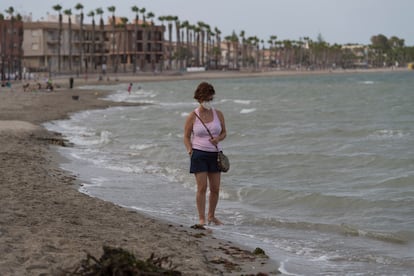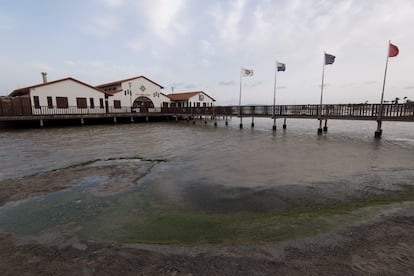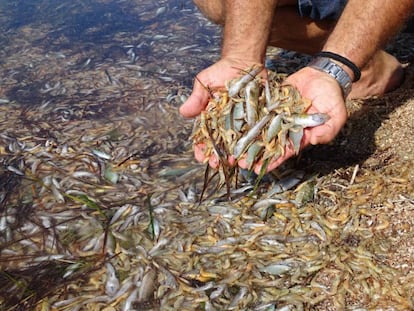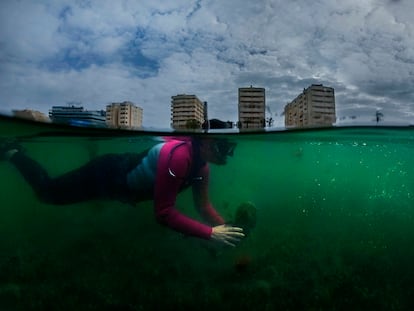Mar Menor’s deserted summer scene: ‘Not even those who own a house here have come’
Water pollution and coronavirus fears are prompting visitors to bypass this once-popular saltwater lagoon on the Spanish Mediterranean


The end of the state of alarm and the arrival of the summer season have seen Murcia’s beaches fill up with visitors, but there is one area of this eastern Spanish region that has been given a wide berth.
Parasols and sun loungers are notably absent on the shores of the Mar Menor due to the saltwater lagoon’s contaminated state, which was exacerbated by torrential rains last fall that yielded shocking images of hundreds of dying fish. Coronavirus concerns have done the rest: this summer, both tourists and vacation-home owners are staying away.
“Unfortunately, there is no problem with space here,” says Ana Pineda, who has spent her summers in Los Urrutias for nearly 50 years. “Both the beach and the whole town are deserted. Almost nobody comes here anymore, not even those who own a house here.”
This area is one of the most-polluted spots in the Mar Menor due to its proximity to the mouth of the Albujón dry creek, which empties large amounts of nitrates from agriculture into the lagoon.
Because the ecosystem is sick, the economy in the entire area is sick tooIsabel Rubio, Pact for the Mar Menor
Pineda defines Los Urrutias as a family town where the beach drove the local economy. Now the sand is little more than a muddy bank and rotting algae continues to be washed ashore, giving off a foul smell. “The beach is open for swimming, but if you put your foot in it, you’ll see how it sinks into the mud. It could even be dangerous,” says Pineda, who is irked by the authorities’ failure to act and their permissive attitude toward certain agricultural practices.
Across the entire area, rain-fed crops have been replaced by irrigated crops, which is at the root of the problem. Nani Vergara, president of Los Nietos Neighborhood Association – also located in the southern area of the Mar Menor – says that last summer there were signs of a recovery, but this year the lagoon is far from inviting.
“The same people are on the beach every year – just those of us who own property here,” says Vergara, who decided to turn her second home into her main residence 12 years ago.
Tourists are harder to come by, she says, an observation that is echoed by Soledad Díaz, president of the Costa Cálida Hotel and Accommodation Association (Hostetur), who declares the state of the Mar Menor to be “dreadful.” Díaz goes on to say that this summer will be especially hard for the tourism sector with coronavirus concerns compounding the stomach-churning images of the lagoon, such as the anoxia episode that caused the death of hundreds of fish on beaches such as Villananitos, in San Pedro del Pinatar, in the northern area of the Mar Menor.
A hotel entrepreneur from San Pedro del Pinatar, who prefers to remain anonymous, assures EL PAÍS that his hotel had 100% occupancy at this time last year, but is now barely at 30%. “The fear of Covid-19 has had an impact because many of our regular customers are older people,” he says. “But the Mar Menor’s well-deserved bad publicity has also played a role.” He uses the word “well-deserved” because he says there has been total “neglect” and the authorities have been blaming one another instead of coming up with a solution.

Nevertheless, there are worse beaches than these. Isabel Rubio, an expert in invasive species and one of the coordinators of the Pact for the Mar Menor grassroots movement, explains that the lagoon has a perimeter of around 70 kilometers and that some stretches are worse than others. The beaches in the northern zone – San Pedro del Pinatar and San Javier – and those along the narrow strip of land known as La Manga are in a more acceptable state than those in the western zone – Los Alcázares – and in the south – Los Nietos and Los Urrutias.
Water sports
Given the circumstances, Hostetur is shifting the focus of this year’s tourism from summer to autumn, when temperatures are still mild around there. The industry group is also switching from the traditional model of sun and beach to water sports. The regional government is also keen on this new focus and the tourism department has launched a campaign in recent weeks to advertise water sports at discounted rates for young clients, and it is funding the initiative with €60,000.
Of all the municipalities in the Mar Menor area, Los Alcázares took the brunt of the torrential rains last fall, and three of its beaches are still closed. Sergio Garijo runs the Aloha sailing school here and he says that the number of water-sports enthusiasts is comparable to other years, but the way in which they engage with the area has changed. “Normally, after finishing a course, they would stay around to swim and eat, and even stay on for a few days,” he says. “Now, they practice the sport and leave.”

Even those who have their vacation home in town prefer to drive to nearby Mediterranean beaches. Ángel Calín, 36, is a case in point. He has spent his summers here since he was a child and still stays in the family’s holiday home. But he no longer uses Los Narejos beach, which he claims is in a worse state now than in the summer of 2016, still remembered by the locals as the “green soup” episode because the lagoon turned green due to the proliferation of algae caused by the excess of nutrients from agriculture. “The water was cloudy then, but this year, the bottom is also muddy from the run-off. As soon as you step away from the shore and venture further in, it feels disgusting,” he says.
Calín is referring to the run-off that empties into the Mar Menor from agricultural activity. Isabel Rubio explains that the change in the agricultural model has been central to the increase in waste.
“There are no terraced fields anymore,” she says. “The natural water courses have been modified, and the rain, even when not torrential, carries agricultural sediments along with it. Because the ecosystem is sick, the economy in the entire area is sick too.”
It is an illness that was there before the coronavirus came along, and everything suggests that it will still be there after the pandemic has gone.
English version by Heather Galloway.
Tu suscripción se está usando en otro dispositivo
¿Quieres añadir otro usuario a tu suscripción?
Si continúas leyendo en este dispositivo, no se podrá leer en el otro.
FlechaTu suscripción se está usando en otro dispositivo y solo puedes acceder a EL PAÍS desde un dispositivo a la vez.
Si quieres compartir tu cuenta, cambia tu suscripción a la modalidad Premium, así podrás añadir otro usuario. Cada uno accederá con su propia cuenta de email, lo que os permitirá personalizar vuestra experiencia en EL PAÍS.
¿Tienes una suscripción de empresa? Accede aquí para contratar más cuentas.
En el caso de no saber quién está usando tu cuenta, te recomendamos cambiar tu contraseña aquí.
Si decides continuar compartiendo tu cuenta, este mensaje se mostrará en tu dispositivo y en el de la otra persona que está usando tu cuenta de forma indefinida, afectando a tu experiencia de lectura. Puedes consultar aquí los términos y condiciones de la suscripción digital.
More information
Últimas noticias
Most viewed
- Sinaloa Cartel war is taking its toll on Los Chapitos
- Oona Chaplin: ‘I told James Cameron that I was living in a treehouse and starting a permaculture project with a friend’
- Reinhard Genzel, Nobel laureate in physics: ‘One-minute videos will never give you the truth’
- Why the price of coffee has skyrocketed: from Brazilian plantations to specialty coffee houses
- Silver prices are going crazy: This is what’s fueling the rally










































